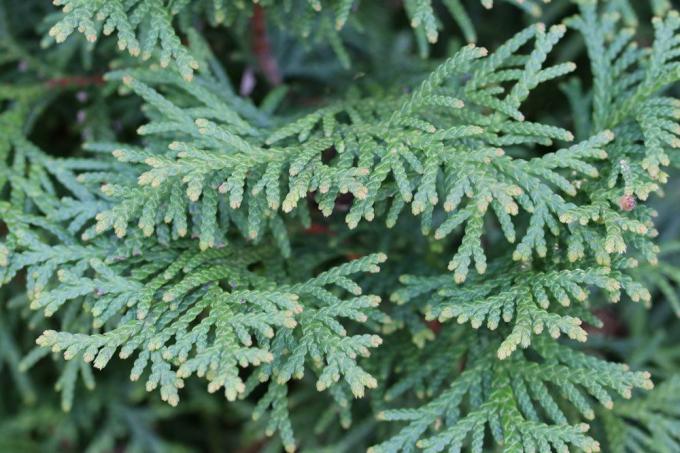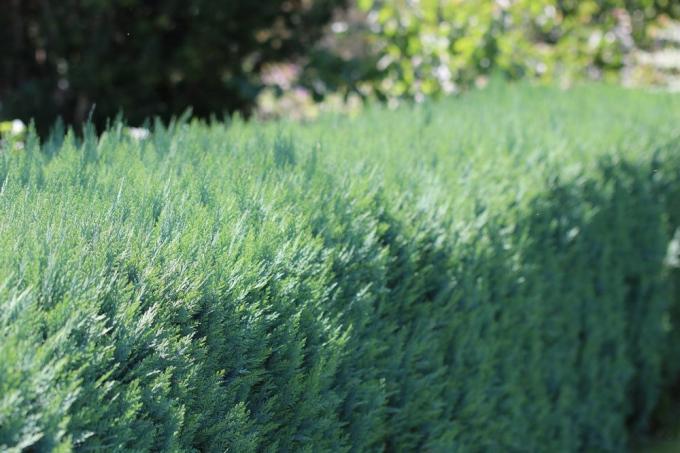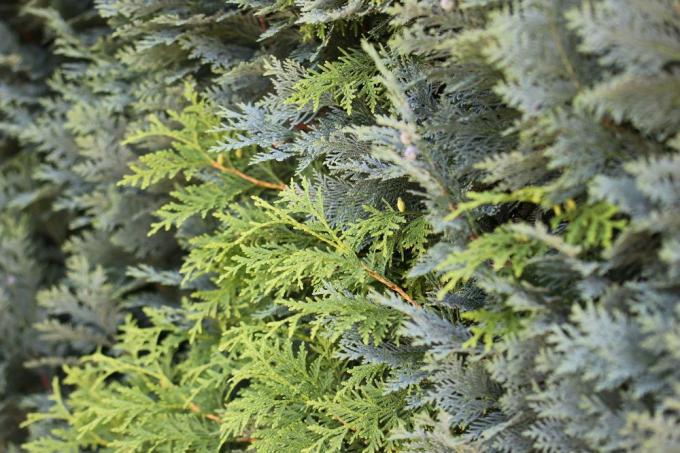
table of contents
- Planting Thuja Brabant
- time
- Location
- floor
- Thuja Brabant as seedlings
- Prefer Thuja Brabant
- Plant spacing
- Planting Thuja Brabant: Instructions
A property with an opaque green border creates privacy to feel good. With the fast-growing thuja, the desired height is reached in no time. The one with the name Brabant is the star among the many varieties for this purpose. It is hardy and allows pruning measures all year round. It endures heat waves as well as bad soils. And the urban climate doesn't seem to bother them any further. How to plant Thuja Brabant.
Planting Thuja Brabant
The tree of life, as the thuja is also called, is usually facing a hedge existence in this country. There is nothing wrong with that. She feels comfortable with a close planting distance. Thanks to its cut tolerance, it remains a pleasing sight, even if it is strictly formed. The Brabant variety in particular is considered the typical Heckenthuja. But don't let that fool you. This evergreen and densely growing conifer is also impressive in its individual position. Whenever you want a green eye-catcher, you can turn to Brabant. Especially when there is not too much space available for the crown. It can be easily shaped into a slender column. Whether it's a hedge or a solitary, it doesn't make much difference when it comes to planting.
time
The Brabant variety is usually sold in pots or pots. Container goods offered. For these earth-rooted specimens, almost every day of the year, apart from hot spells and frosty days, is considered a suitable time for planting. However, if you want to get the best possible result, you should also wait for the most appropriate time:
- Spring is the ideal time to plant
- greatest frosts should be over
- Earth should be warmed up a bit
- The best time is in April and May
- alternative planting time is late summer / early autumn
New roots are formed more quickly in spring than in autumn. If thuja planted in autumn do not take root well in time for the cold snap, it may be that they will not survive the winter.
tip: Postpone planting even if the soil is too wet due to prolonged rainfall.
Location
Thuja occidentalis Brabant, as the full-length botanical name is, likes a sunny spot. However, it is good if the tree of life does not feel the full power of the sun at lunchtime. Light shadows, on the other hand, do not harm it. If the tree of life has to get in close contact with other specimens, its place should also be well ventilated. But be careful with dry winds, they can damage the plants.
floor
These trees of life grow well in water-permeable soils. It can be loam, sandy or heavy clay soils, as long as a drainage layer is integrated into the planting. Although it adapts to all soils, this plant does not like waterlogging. Nutrient-rich sandy and loamy soils are preferred. Here are a few more key data about the ideal soil condition for this thuja variety:
- neutral to sour is best
- with pH between 6 and 8
- Avoid swampy and poorly drained soils
- Shake up the soil in a hill-like shape in wet locations
- This allows water to drain off better
- moisture must be retained on dry floors
- after planting, it is necessary to spread thick bark mulch
- Avoid very calcareous soils as the leaves turn yellow
Thuja Brabant as seedlings
You can buy young plants cheaply in tree nurseries, garden centers and numerous online shops. The smaller the tree on offer, the cheaper it is in price. Most shops offer a volume discount for large orders. Buy the thuja just before you start the hedge planting project. But this also applies if you want to plant the thuja as a solitary tree.
If you have access to a Thuja Brabant that is not too old, you can pull further specimens from cuttings very reliably and inexpensively. Plant extraction is described in more detail below.
Prefer Thuja Brabant
The ideal time for this project is around the end of June. The fresh shoot of the year is then sufficiently lignified. The warm temperatures also promise that the cuttings will take root quickly. The so-called. Cracks are ideally suited. These are thin side branches that are not cut, but torn off. They form roots more reliably than cut cuttings. This is how you do it:
- select Side branches in hidden places
- so no unsightly gaps are left behind
- Tear off cracks directly at the branch
- remove its lower side branches
- Shorten other side branches and tip
- cut off the torn end of the bark with scissors
- Fill the large bowl with nutrient-poor potting soil
- poke evenly holes with a stick
- Plant cracks, they should not touch
- Place it in the shade and cool outside
- Cover with foil or a transparent lid
- Ventilate the cover every few days
- Keep the soil moist throughout
After a few weeks, the cracks will have enlarged significantly. The young saplings may not be planted until next spring. An earlier point in time will not do them well outdoors. So let them grow in the pot over the winter.
Plant spacing
as a hedge
In a hedge, the trees of life must be planted with a suitable spacing. A middle way has to be found. On the one hand, the plants should be sufficient Space for your development receive. On the other hand, the distance must not be too large so that the hedge quickly becomes opaque. How many plants per running. Meters to be planted depends on their height together:
- up to 40 cm: 5 plants per meter
- Heights up to 80 cm: 4 plants per meter
- up to 1.5 m: 3 plants per meter
- up to 2 m: 2 plants per meter
- larger specimens: 1 plant per meter

in solitary plants
If the Thuja Brabant is planted in a solitary position, it also needs enough distance to other plants or structures so that it can develop freely all around. At the beginning of their existence the space requirement is still small. But that will change. The conical crown can reach a maximum width of 3 - 4 m with age. That is why it is better to close the space during their “youth” with annual varieties of flowers that can be removed at any time if necessary.
Planting Thuja Brabant: Instructions
When the planting time has come, it is a good idea to proceed as follows:
- Water the root ball by placing the pot in a bucket filled with water until no more bubbles appear.
- Carefully loosen the root ball. Then remove some of the thicker roots to encourage root growth.
- Dig a planting hole that should be at least twice as large as the root ball of the tree of life. If you want to plant several conifers as a hedge, you should dig a planting pit.
- Mix the excavated material with compost or rotted horse manure.
- Loosen up the subsoil. Remove stones, roots and large clods of earth.
- If necessary, create a drainage layer. Sand and coarser gravel can be used for this.
- Measure and mark the distance between two copies.
- Place your thuja hedge plants in the planting pit. You should not stand any deeper in it than before in the pot. Rotate each plant so that its prettiest side is in the direction from which you will see it most later. Look at the plants from several meters away. This will make it easier for you to see whether you are standing straight.
- In windy locations, you can use support posts next to each tree. Strong movements would be felt right down to the roots and disrupt their roots. The support posts can be removed later.
- Carefully spread the roots out in the planting hole and fill in the gaps with the excavated material.
- Tread the earth with little pressure.
- Immediately after planting, water the thuja extensively.
- If the soil tends to be dry, you should spread a 10 cm thick layer of mulch immediately after planting. Cover the root base about half a meter in diameter.
- Continue to water the young thuja regularly and depending on the weather. You have to pick up the pot every 2 to 3 days. A large watering can per meter of height of the tree of life is a guideline for the amount of water.
- Even in the first three years, the water supply of these conifers must be kept an eye on until they have formed enough root mass and can adequately supply themselves.
- If the young trees are exposed to stronger winds, you should take suitable measures to protect them from drying out. For example with perforated foil, sackcloth, etc. Ä.

tip: The soil in the planting trench should be a little deeper than the surrounding soil. This makes watering easier because the water cannot flow away.




